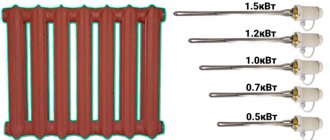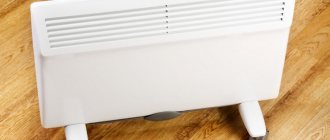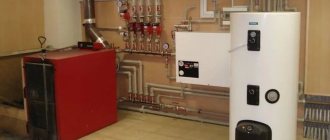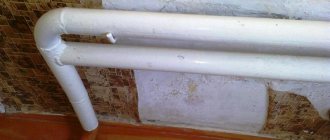In most cases, the majority of people think about the reliability and efficiency of the heating system after a certain failure has occurred in it. It is extremely important that no significant mistakes are made at all stages of the design, selection and installation of such a system. To avoid serious heating errors, the installation of a heating system in a house must be approached with the utmost responsibility.
1-Selection of boiler
What causes the most trouble for a person is the wrong choice of heating boiler. Moreover, its selection is determined not only by the spaciousness of the apartment. If the boiler power is higher than required, the monthly costs for heating equipment will greatly increase. But it will be much worse if the boiler power is too small compared to what is needed. Then there will be a catastrophic lack of heating during the cold season.
It is important to study not only the boiler power, but also the efficiency. This indicator is as significant as the previous one.
2-Pipe selection
The pipes must be the same diameter. Otherwise, hydraulic losses begin to increase due to the fact that the pressure at the joints will differ. An error will occur in the functioning of the heating system.
Important!
When choosing pipes, you need to pay attention to the reinforcing layer. If it is missing, then the line will not have enough rigidity to resist the influence of hot water.
3-Selection of heating scheme
Developing the right diagram is one of the most important elements when installing a heating system. There is no scheme that would be equally suitable for different rooms. Each is calculated and selected based on the individual characteristics and features of the room.
This scheme is being developed by plumbers. It is recommended to hire designers to compare the results. This will slightly increase the accuracy of the calculations. You should be careful with information on the Internet, since the most common options are presented very briefly there. Sites on this topic are sometimes full of shortcomings.
It would be more advisable to spend time calculating the heating circuit at the very beginning of work than to correct them later. Adjusting the system after installation will take much longer and require more financial costs. It is better to entrust the calculations to experienced specialists in advance.
Correct layout
Installing or updating a heating system should start with creating a competent project. In an ordinary city apartment, which is heated centrally, there are few opportunities to transform the existing situation - you can replace the pipes with more modern ones and install more efficient and visually attractive radiators.
In a private house or cottage, there are much more options for heating schemes. So the heating design here should be approached much more responsibly and all the nuances should be worked out in advance and taken into account on paper before construction begins.
First of all, the required boiler power is calculated based on the layout of the building, its area, ceiling height, as well as the thickness and type of walls. The optimal type of fuel (gas, diesel, electricity, etc.) is also taken into account. The next stage involves developing a pipe routing diagram, choosing the type of radiators, their location, as well as considering other aspects. It is at this stage that a number of serious mistakes are made, which will certainly result in problems in the near future.
Many homeowners know that heating systems based on the circulation principle are divided into two main types:
– gravity circuit (with natural circulation);
– circuit with forced circulation of coolant (antifreeze or water).
The first type is characterized by the fact that the liquid moves through heating devices and pipes due to different densities in the hot supply and cold return lines. In the second, fluid circulation occurs due to the operation of circulation pumps. Each type has its own characteristics, which should be taken into account when calculating and selecting components.
The option built according to the first - gravitational - scheme can do without a pump and does not depend on the availability of electricity. However, the design features allow this option to be used only for one- and two-story houses and cottages with an area of no more than 100-150 square meters. m. Adjustment of this type of heating occurs only by increasing or decreasing the boiler power, and for uninterrupted efficient operation of the system, expensive pipes with a diameter of at least 50 mm will be required. When laying pipes, the slope angles must be strictly observed. It is clear that the consumption of materials, and therefore financial costs, increases significantly.
An open expansion tank is usually introduced into the above-described circuits, which is necessary to compensate for the increase in coolant volume under the influence of high temperatures. Accordingly, the liquid comes into direct contact with atmospheric air and is saturated with oxygen. As a result, steel products are exposed to much more intense corrosion. The problem in such cases can be solved only by using cast iron batteries, which are not subject to oxidation and are especially resistant to operation in aggressive environments.
The most popular options today with a circulation pump allow the use of pipes with a smaller cross-section, which leads to greater feasibility from an economic point of view. In addition, they, as a rule, belong to closed-type systems, that is, they use membrane expansion tanks, where hot water does not have the opportunity to come into contact with open air, which allows the use of a wide variety of modern heating devices: steel panel and tubular models, bimetallic and aluminum design radiators. But even here, the problem of rust remains relevant, since in real life, both in autonomous (with intensive recharge) systems and in centralized systems, the oxygen content in the coolant is ten to twenty times higher than that specified in domestic standards (no more than 0.02 g/l). In this case, modern radiators with anti-corrosion internal coating will come in handy.
As a rule, shortcomings in the work of installers of new batteries will not appear immediately. They are often difficult to notice even for specialists. And at the most inopportune moment, that is, during the heating season, shortcomings and installation errors will make themselves known loudly. It won’t be difficult to recognize them: either the battery will leak, or there will be an unexpected decrease in the power of the system, which will simply make the house or a specific room cold.
5-Selection of circulation pump
There are programs that allow you to calculate hydraulics. The resistance that pipes and various devices provide is determined, and it is demonstrated how much the pressure can drop under the influence of a particular pump.
Then you can select a pump. Its pressure must overcome the created resistance. If the pump pressure is not enough for resistance, then the heating system will malfunction.
Note!
When selecting a pump, it is also important to pay attention to what noise it will make, what size it reaches, what are the features of its maintenance, etc.
Tools are the most important quality factor
The main mistakes of installers, for which customers then have to pay, are quite typical. The most common is the lack of suitable tools among craftsmen or their low quality. What is the first thing that comes to mind when it comes to plumbing fixtures? Of course, universal and adjustable gas wrenches. But gone are the days when only these tools were enough for a plumber.
A set that includes both of the above items, which must be of high quality, can be considered optimal, as well as a special key for metal-plastic pipes and a stepped one, which is necessary for detachable connections.
Experts pay tribute to models from Swedish and German brands (for example, Bo1belger, Petz, Pico, Rogec1), but they have a drawback (inherent in all quality things) - they are very expensive - about 1.4 thousand rubles. a piece. “Budget” analogues are often of poor quality and are made of low-quality steel that cannot withstand prolonged loads. As a result, the plumber may not tighten the connections completely, fearing for the safety of the equipment, which sooner or later will inevitably lead to coolant leaks, or even to a system breakthrough.
We understand that it is difficult to correctly install a thermostat if you only have a sledgehammer and a pair of keys in your arsenal, because thermostats are responsible for controlling the radiator and, therefore, the temperature in the room. If you break the threads or deform the parts of the device, you can get a whole range of problems, because the contact point will one day not withstand the pressure in the system.
Misconceptions and mistakes
It is interesting that many misconceptions are often considered canon and every time the installation is performed incorrectly. For example, radiators are hung strictly horizontally. This is incorrect, because in this position air gradually begins to accumulate in the batteries - there is simply no “exit” for it. You will have to periodically bleed it manually using a special air valve (as a result, the power of the heater is reduced), or provide for a slight tilt of the unit to the left or right at the stage of installation under the window sill. Unfortunately, not only apartment owners, but also some specialists do not always remember this.
Pipe connections, especially threaded ones, must be sealed to avoid leaks. Previously, plumbing flax was most often used as a sealant. Today it can be found extremely rarely; Teflon thread is more popular among specialists. They also use special heat-resistant silicone, but be careful - its cheaper analogue for plastic windows is designed for a completely different temperature regime. As soon as the heating system starts working, this composition will not be able to withstand the heating, which is fraught, if not with a breakthrough in the system, then with a coolant leak.
Experienced summer residents know that autonomous heating systems should be filled not with water, but with a more frost-resistant composition. But the use of antifreeze in this role must impose certain technical restrictions on the design of the heating system, which, unfortunately, are not always taken into account. Thus, there are special requirements for gaskets and sealants. For example, ordinary rubber products, which are usually installed in cast iron radiators, swell and lose their performance properties when exposed to ethylene glycol-based antifreeze. The result is sad and predictable - a leak.
As a rule, experts have a very negative attitude towards antifreeze as a working fluid. This is explained by the fact that heating boilers are designed for the physical properties of water (its viscosity, thermal conductivity, etc.). Any change in this data increases the likelihood of boiler emergency shutdowns due to overheating or even its premature failure.
Don't go for cheap
In order for the installations responsible for heating the room, and therefore for your coziness and comfort, to operate smoothly and efficiently, you should use only proven shut-off valves: ball valves, gate valves, etc. Unfortunately, in the domestic market you can find not only really high-quality products Russian and foreign production, but also many fakes. And if an installer or homeowner decides to save money and buy an affordable product at a fantastically low price, then with a very high degree of probability it will turn out to be a cheap fake, made from short-lived materials whose qualities do not meet the requirements. Consequently, the system will fail much earlier than we would like.
On average, a homeowner will have to spend at least three thousand rubles to ensure that radiators are equipped with high-quality fittings.
6-Selection of expansion tank
A tank is an element of the heating system, which is a container that can be used to compensate for the expansion of the liquid during heating. When selecting a tank, it is important to first carefully study each parameter of the system, otherwise there is a risk of making a significant mistake. It threatens a complete failure of the heating system.
The volume of the tank should be equal to 15% of the coolant. Therefore, when choosing, it is better to give preference to those models that are larger in volume than required. Large tank sizes do not affect the heating process in any way, while a lack of size results in problems.
What it is
Let's start with definitions.
- A one-pipe heating system is a simple ring between the supply and return shut-off valves in the elevator unit or between the boiler outlet and inlet. One pipe, parallel to which (or opening it, which is fundamentally wrong, but is practiced) heating devices are embedded.
A multi-storey building may have several such rings, one on each floor or even in each apartment. More often, however, one-story cottages are heated in this way.
- A 2-pipe heating system implies the presence of two pipelines along the entire heated perimeter of the premises. Heating devices cut between them, creating hydraulic bridges and dampening the pressure drop.
This gives rise to a number of problems; however, with a properly configured heating system, even with a very large area of the house and a huge number of heating devices, their temperature can be approximately the same. That is why we most often see this scheme in apartment buildings.
Single-pipe and two-pipe heating systems differ in the complexity of the wiring and material consumption . It is clear that two pipes will cost more.
7-Purchase of a thermal head
Recently, thermal heads used for radiators have become popular. They allow you to manually adjust the heating temperature inside the room itself. But they cannot always be used. Thermal heads cannot be used when there is a solid fuel boiler in the room. The fact is that it heats the air in the room to the desired level, and then each thermal valve of the radiators closes immediately. Then the boiler temperature rises to boiling. This is where an emergency is likely to occur.
Installing a heating system is by no means as simple as it seems at first glance. It is preferable to entrust the calculation work to experienced specialists. This will help eliminate the possibility of emergency situations and system failures.
To avoid such troubles, you need to ensure that during installation of the heating system at least some of the radiators are left without the manual control function.
Get a quote











